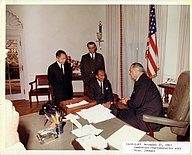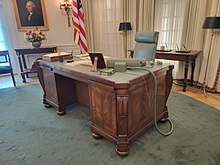
Lyndon Baines Johnson, often referred to by his initials LBJ, was an American politician who served as the 36th president of the United States from 1963 to 1969. He became president after the assassination of John F. Kennedy, under whom he had served as the 37th vice president from 1961 to 1963. A Democrat from Texas, Johnson also served as a U.S. representative and U.S. senator.
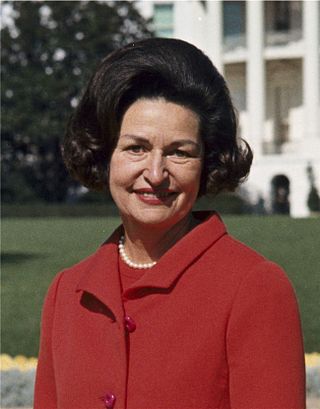
Claudia Alta "Lady Bird" Johnson was the First Lady of the United States from 1963 to 1969 as the wife of President Lyndon B. Johnson. She served as the second lady from 1961 to 1963 when her husband was vice president.
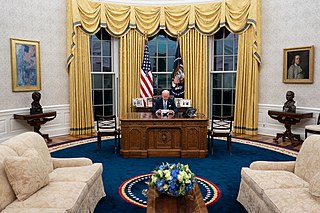
The Oval Office is the formal working space of the president of the United States. Part of the Executive Office of the President of the United States, it is in the West Wing of the White House, in Washington, D.C.

The Lyndon Baines Johnson Library and Museum, also known as the LBJ Presidential Library, is the presidential library and museum of Lyndon Baines Johnson, the 36th president of the United States (1963–1969). It is located on the grounds of the University of Texas at Austin, and is one of 13 presidential libraries administered by the National Archives and Records Administration. The LBJ Library houses 45 million pages of historical documents, including the papers of President Johnson and those of his close associates and others.

The Resolute desk, also known as the Hayes desk, is a nineteenth-century partners desk used by several presidents of the United States in the White House as the Oval Office desk, including the five most recent presidents. The desk was a gift from Queen Victoria to President Rutherford B. Hayes in 1880 and was built from the oak timbers of the British Arctic exploration ship HMS Resolute. The 1,300-pound (590-kilogram) desk was created by William Evenden, a skilled joiner at Chatham Dockyard in Kent, probably from a design by Morant, Boyd, & Blanford. The desk has been modified twice, with a kneehole panel added in 1945 and a 2-inch-tall (5.1 cm) plinth added to the desk in 1961.

The Yellow Oval Room is an oval room located on the south side of the second floor in the White House, the official residence of the president of the United States. First used as a drawing room in the John Adams administration, it has been used as a library, office, and family parlor. It was designated the Yellow Oval Room during the restoration overseen by First Lady Jacqueline Kennedy. Today the Yellow Oval Room is used for small receptions and for greeting heads of state immediately before a State Dinner.

Lyndon B. Johnson's tenure as the 36th president of the United States began on November 22, 1963, upon the assassination of president John F. Kennedy, and ended on January 20, 1969. He had been vice president for 1,036 days when he succeeded to the presidency. Johnson, a Democrat from Texas, ran for and won a full four-year term in the 1964 presidential election, in which he defeated Republican nominee Barry Goldwater in a landslide. Johnson did not run for a second full term in the 1968 presidential election because of his low popularity. He was succeeded by Republican Richard Nixon. His presidency marked the high tide of modern liberalism in the 20th century United States.

The first inauguration of Lyndon B. Johnson as the 36th president of the United States was held on Friday, November 22, 1963, aboard Air Force One at Dallas Love Field, following the assassination of President John F. Kennedy earlier that day. The inauguration – the eighth non-scheduled, extraordinary inauguration to ever take place – marked the commencement of the first term of Lyndon B. Johnson as president.

The desk in the Vice President's Room of the United States Capitol, colloquially known as the Wilson desk and previously called the McKinley-Barkley desk, is a large mahogany partner's desk used by U.S. Presidents Richard Nixon and Gerald Ford in the Oval Office as their Oval Office desk. One of only six desks used by a President in the Oval Office, it was purchased in 1898 by Garret Augustus Hobart, the 24th Vice President of the United States, for the Vice President's Room in the United States Capitol.
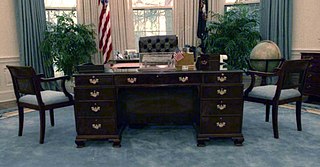
The C&O desk is one of six desks ever used in the Oval Office by a sitting President of the United States. The C&O Desk was used in the executive office by only George H. W. Bush, making it one of two Oval Office desks to be used by only one president there. Prior to its use in the Oval Office by Bush, the desk had been in use elsewhere in the White House. It is the shortest-serving Oval Office desk to date, having been used for one four-year term.

The Vice President's Room is the vice president's office in the United States Capitol, added during the 1850s expansion.
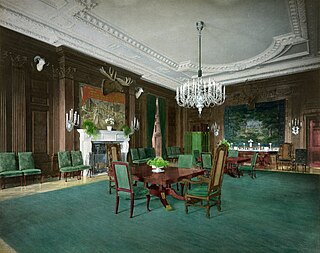
A. H. Davenport and Company was a late 19th-century, early 20th-century American furniture manufacturer, cabinetmaker, and interior decoration firm. Based in Cambridge, Massachusetts, it sold luxury items at its showrooms in Boston and New York City, and produced furniture and interiors for many notable buildings, including The White House. The word "davenport," meaning a boxy sofa or sleeper-sofa, comes from the company.

The desk in the Vice President's Ceremonial Office in the Eisenhower Executive Office Building, colloquially known as the Theodore Roosevelt desk, is a large mahogany pedestal desk in the collection of the White House. It is the first of six desks that have been used by U.S. presidents in the Oval Office, and since 1961 has been the used as the desk of the U.S. Vice President.

The Hoover desk, also known colloquially as FDR's Oval Office desk, is a large block front desk, used by Presidents Herbert Hoover and Franklin D. Roosevelt in the Oval Office. Created in 1930 as a part of a 17-piece office suite by furniture makers from Grand Rapids, Michigan, the Art Deco desk was given to the White House by the Grand Rapids Furniture Manufacturers Association during the Hoover administration. The desk was designed by J. Stuart Clingman, and was built by the Robert W. Irwin Company from American lumber and faced with Michigan-grown maple burl wood veneer. After Roosevelt's sudden death in 1945, Harry S. Truman removed the desk from the Oval Office and gave it to Roosevelt's wife, Eleanor Roosevelt. She displayed it at, and later donated it to, the Franklin D. Roosevelt Presidential Library and Museum in Hyde Park, New York. The desk has been on display there ever since. The Hoover desk is one of only six desks to be used by a president in the Oval Office.

The United States foreign policy during the 1963-1969 presidency of Lyndon B. Johnson was dominated by the Vietnam War and the Cold War, a period of sustained geopolitical tension between the United States and the Soviet Union. Johnson took over after the Assassination of John F. Kennedy, while promising to keep Kennedy's policies and his team.

The United States Senate's hideaways are about 100 secret offices in the U.S. Capitol building used by members of the Senate and by a few senior members of the U.S. House of Representatives. Their locations are unlisted in any official directory, and their doors are marked only by a room number. Senators use hideaways as a private space to prepare for sessions of the Senate, conduct confidential meetings, take naps, and for other personal purposes. They range from lavish and expansive upper-floor offices to small, cramped offices in the basement. Hideaways are assigned to senators based on seniority. The history of hideaways dates to the earliest occupancy of the U.S. Capitol in 1800. However, they proliferated in the early 20th century.

Let Us Continue is a speech that 36th President of the United States Lyndon B. Johnson delivered to a joint session of Congress on November 27, 1963, five days after the assassination of his predecessor John F. Kennedy. The almost 25-minute speech is considered one of the most important in his political career.

Some presidents of the United States have had a red call button in the Oval Office of the White House that could call aides. The earliest incarnation dates to 1881 or before, and the modern call button has been in a wooden box on the Resolute desk since at least the George W. Bush presidency (2001–2009).

The presidential transition of John F. Kennedy began when he won the 1960 United States presidential election, becoming the president-elect of the United States, and ended when Kennedy was inaugurated at noon EST on January 20, 1961.


